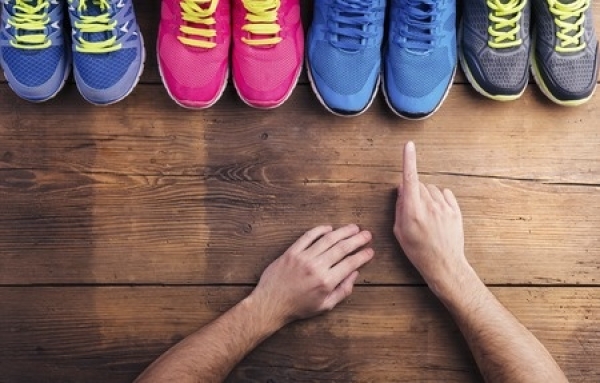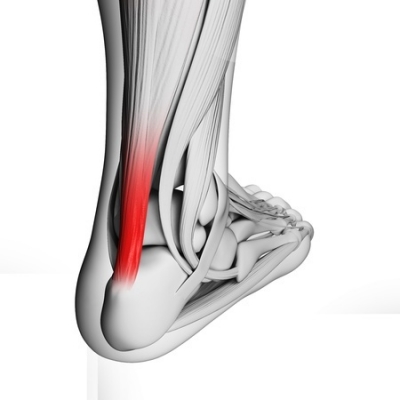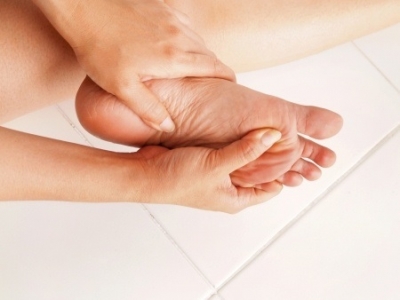Connect With Us
Blogs

Foot Care (19)
When it comes to running or walking for exercise, we at Superior Foot & Ankle Center believe that the most important piece of equipment required is a good shoe that is properly fitted for your individual foot. You do not need different shoes for running and walking. Running shoes usually have more shock absorption and are fine for walking.
Below are some tips to help you choose the right shoe and get a good fit:
- Start with an appointment with one of our podiatrists, Dr. Victoria Foley or Dr. Constance Ornelas. The right shoe for you will depend on your foot type. If you have a high arch or you wear a custom orthotic device, a cushioned neutral shoe is best. For someone with flat feet, a stability shoe is recommended. See our approved shoe list for specific brands and styles. Your foot doctor can make suggestions for particular styles or features if you have a toe deformity or other foot or ankle condition that will help protect the area and make running or walking more comfortable.
- Get professionally fitted by a sports shoe expert. Most people have two different size feet. It’s essential to buy shoes to accommodate the larger foot. There should be a half-inch of space between your longest toe and the front of your shoe. A majority of people wear shoes that are too small for their feet and this leads to injury and deformity.
- Wear the socks you will run or walk in when you go to try on shoes. We recommend a cotton blend or a sock with CoolMax. Bleach white socks to prevent athlete’s foot.
- To avoid blisters, be sure that the heel of the shoe fits snugly and that the foot doesn’t slip when you walk. Also, run your hand around the inside of the shoe to check for rough stitching or bumps that can cause friction and result in a blister.
- Take your time when trying on shoes. Walk around the store for several minutes. Many running shoe stores will have a treadmill so that you can try running in the shoes as well.
- Remember to replace running/walking shoes after approximately 400 miles. Even good shoes lose their supportiveness once they are worn out and wearing them can present an increased risk of injury.
If you have more questions about running or walking and your feet, contact our Long Beach office by calling us at 562-420-9800.
If getting in shape is one of your New Year’s resolutions, we at Superior Foot & Ankle Center would like to encourage you to consider walking. Walking is a very effective exercise, particularly if you have been inactive in the recent past. Consider these benefits:
- Can be done all year round outdoors (especially with our beautiful Long Beach weather) or indoors on a treadmill
- Walking is an activity that can be enjoyed alone or with others
- Walking lowers blood pressure, blood sugar and cholesterol while also providing a cardiovascular workout, improved circulation, stress relief and weight loss
- No special equipment is needed (except a good pair of walking shoes)
Of course walking can cause problems as well. Blisters, corns and calluses, plantar fasciitis, shin splints, and Achilles tendonitis are all potential conditions that can occur as a result of walking. You can help prevent these problems from developing, however, by following a few simple tips:
- Make an appointment for a podiatric check up before starting your new walking routine. Our board certified foot and ankle surgeons, Dr. Victoria Foley and Dr. Constance Omelas will examine your toes, feet and ankles and determine if there are any pre-existing problems that need to be treated. The foot doctor can also analyze your gait and see if you tend toward over-pronation, which may affect your shoe choice.
- Choose a sensible walking program that starts out slow and gradually increases distance and intensity.
- Always remember to stretch before and after you walk.
- Invest in good walking shoes and get professionally fitted at a sports or fitness store.
A little soreness or stiffness when you start a new fitness routine is normal but if you find you are experiencing ongoing pain or any swelling or other unusual symptoms contact our Long Beach office by calling: 562-420-9800.
The holiday season has you on your feet more than usual: shopping at the mall, extra trips to the grocery store, parties after work, etc. At Superior Foot & Ankle Center we see an increase in many types of foot problems at this time of year just because people are on their feet so much more than usual. Do yourself a favor and make the first gift on your list be a well-made, properly fitting pair of shoes to do all your holiday errands in. Here are some shoe shopping tips:
- Choose flat shoes or ones with heels no higher than one inch
- Be sure soles have a good tread that will help you avoid falls on slippery sidewalks and parking lots
- Avoid shoes with narrow toe boxes that squeeze toes together; this can encourage ingrown toenails
- Look for breathable, natural materials that allow air to circulate to reduce the change of athlete’s foot and other fungal infections
- Run your hand all around the inside of the shoe to check for loose stitching or seams that can rub against the skin and cause irritation
- Shoe shop at the end of the day—that’s when feet are at their largest
- Make sure there is at least a half inch between the tip of your big toe and the end of the shoe
- If one of our podiatrists, Dr. Victoria Foley and Dr. Constance Omelas have prescribed special orthotic devices be sure to bring them to try on with your shoes
- Wear socks that are similar in thickness to the ones you will wear with your new shoes
- Try on both shoes and walk around for several minutes in the store. Shoes should be comfortable from the moment of purchase—don’t count on them feeling better after they are “broken in.”
- If you have any special foot needs—diabetic, hammertoes, bunions or other foot deformities or conditions, ask the foot doctor’s advice on the best shoes for you. You can always contact our Long Beach office with questions by calling (562) 420-9800.
The day after a particularly intense workout or a long run you may notice pain ranging from mild to extreme in the lower part of the back of your leg. Or, you may be noticing a sluggish feeling in your leg accompanied by stiffness and/or a dull ache that lessens as you stretch the leg and get going with your day. All of these are possible symptoms of Achilles tendonitis—an inflammation of the large tendon that runs between the bottom of your calf muscle and your heel that we see often at Superior Foot & Ankle Center.
Tendonitis is primarily caused by overuse or trauma to the tendon. Scenarios that can result in inflammation and injury to the Achilles tendon include:
- Suddenly increasing the distance or intensity of your run or workout
- Doing too much too soon in a new exercise routine or starting up after a period of inactivity
- Overpronation
- Inappropriate footwear choices
- Not stretching enough before sports or exercise
- A trauma to the tendon caused by a sudden or wrenching movement (like taking off for a sprint)
- Heel bone deformity
- Age related wear and tear
Treatment and Prevention
Mild cases of Achilles tendonitis can be resolved by resting the leg and avoiding activities that put stress on the tendon. If the pain is persistent however, and doesn’t seem to improve with rest, it’s time for an appointment with one of our podiatrists, Dr. Victoria Foley or Dr. Constance Omelas. The foot doctor can evaluate just how severe the tendonitis is and make recommendations for relief. These may include: icing, specific stretching exercises to do before and after exercise and a heel cup or other orthotic device to help prevent overpronation and increase arch support. Wearing properly fitting shoes that are designed for the sport or activity you do and following a sound program that increases in intensity gradually can help prevent inflammation the Achilles tendon.
To learn more about how to prevent or treat Achilles tendonitis, call our Long Beach office at: (562) 420-9800.
According to the American Podiatric Medical Association, most Americans will have put 75,000 miles on their feet by the time they reach the age of 50! Although in some ways our lives have become more sedentary than in previous generations we now engage in much more rigorous fitness activities to compensate then in times past which can mean even greater wear and tear on feet and ankles. Take running, for example, which puts pressure on each foot equivalent to 3 to 4 times the weight of your body. Even walking for a person who weighs 150 pounds will exert an estimated 127,000 pounds of pressure per foot per mile. At Superior Foot & Ankle Care Center we want to share these figures to help you gain more respect for your feet and the importance of caring for them. Your feet are wonderfully made complex structures comprised of 26 bones, 33 joints and more than 100 muscles, tendons and ligaments. You can help keep your feet healthy and prevent many common problems by following a few footcare basics:
- Develop a regular care regimen. Wash feet daily and dry thoroughly (especially between the toes). Apply a rich moisturizer to keep skin supple and hydrated. If you tend to sweat excessively, use a talc or anti-fungal foot powder as well.
- Make good shoe choices. Poorly fitting shoes are one of the biggest causes of foot problems. Be sure that toes are not squeezed and that the shoes you wear provide good arch and ankle support. Avoid overly high heels and discard shoes when they are worn out.
- Exercise wisely. Being fit is important for your feet and the rest of your body too. Regular exercise is recommended but be sure to start gradually and work up to longer and more intense workouts in order to avoid injury.
- Inspect your feet periodically. Look for changes in size, shape, skin color or temperature as well as any lumps, bumps or unusual changes in your toes. Most foot problems are more successfully treated and with less invasive means if caught in the early stages. Report anything suspicious to your foot doctor.
- Don’t ignore pain in your feet—it’s never normal! Our board certified podiatrists, Dr. Victoria Foley and Dr. Constance Omelas will conduct a thorough examination of your feet and diagnose the source of your pain. A custom treatment plan will soon have you on track to getting back to the active lifestyle you normally enjoy. Contact our Long Beach office by calling: 562-420-9800 for an appointment.





